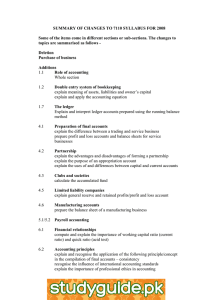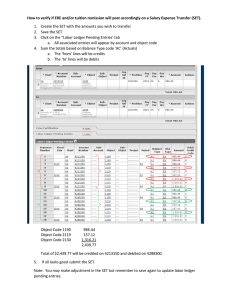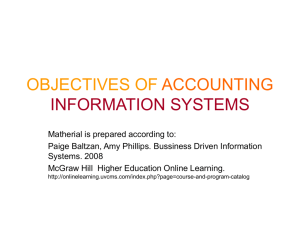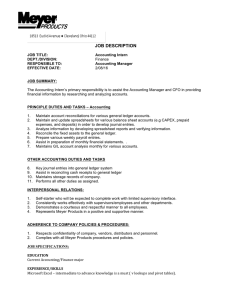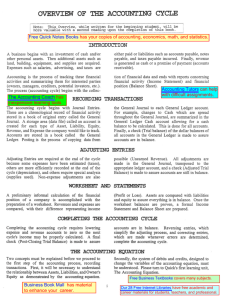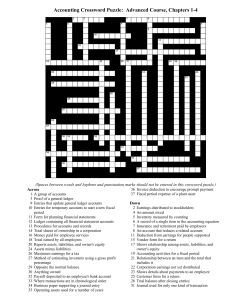Accounting Syllabus - Examinations Council of Lesotho (ECoL)
advertisement
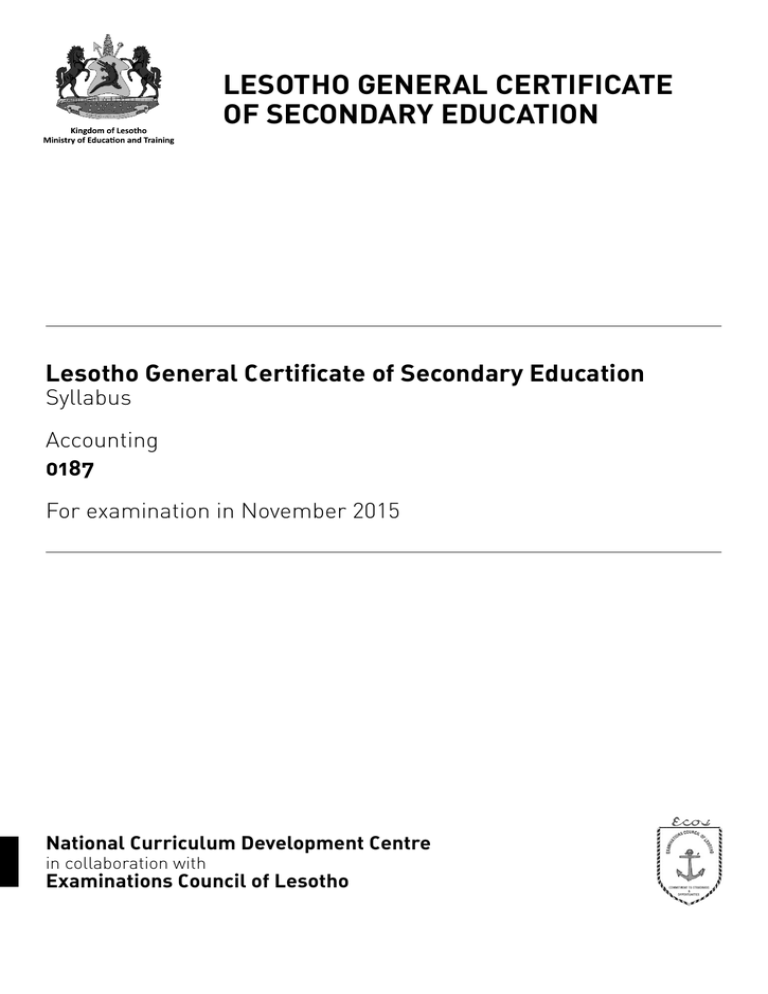
LESOTHO GENERAL CERTIFICATE OF SECONDARY EDUCATION Lesotho General Certificate of Secondary Education Syllabus Accounting 0187 For examination in November 2015 National Curriculum Development Centre in collaboration with Examinations Council of Lesotho 1.Introduction The Lesotho General Certificate of Secondary Education Accounting syllabus is tailor-made to instil entrepreneurial culture in the learners and to form a sound base for further learning in the Commercial field. 2.Rationale: This syllabus is intended to prepare and expose learners to the global business world faced with economic challenges and recurring economic recessions. Products of this syllabus should be able to find their rightful place in the business world, contribute and participate meaningfully. Learners are to develop a good appreciation of the accounting principles and practices internationally so as to become competitive in a dynamic business environment. The syllabus further encourages learners to develop analytical attributes and entrepreneurial skills to be able to evaluate various business scenarios and make informed judgements. Products of this syllabus are to demonstrate high numeracy, literacy, research skills to enhance recording, accounting and decision-making 3. Assessment at a glance For Lesotho General Certificate of Secondary Education (LGCSE) in Accounting, candidates take two compulsory components: Paper 1 and Paper 2. Candidates take: Paper 1 Description This is a structured question paper with 12–15 multiple choice questions and short answer questions. There are usually between 4 and 5 questions based on topics from the whole of the syllabus. All questions are compulsory, and candidates answer on the question paper. Weighted at 33.3% of the total marks Duration Marks 1hr 15 mins 50 Duration Marks 2 hrs 100 AND Paper 2 © ECol 2015 Description This is a structured question paper. There are usually 4 to 6 questions based on topics from the whole syllabus. All questions are compulsory, and candidates answer on the question paper. Weighted at 66.6% of total marks 2 Paper availability This syllabus shall be examined in the May/June examination sessions and the October/November examination series. It is also available to private candidates. 4. Syllabus Aims The aims of Lesotho General Certificate of Secondary Education Accounting syllabus are to: develop knowledge and understanding of the principles and purposes of accounting for individuals, businesses, non-trading organisations and society as a whole ● develop knowledge, skills and attitudes to establish businesses that are environmentally friendly ● develop an understanding of accounting principles, procedures, techniques and terminology ● develop skills in preparing and interpreting accounting information • develop skills of numeracy, literacy, communication and enquiry ● encourage attitudes of accuracy, orderliness, logical thought and an appreciation of professional ethics ● develop an excellent foundation for advanced study ● develop some appreciation of information and communications technology in accounting. ● Teachers are expected to relate the content of the syllabus to local and national events. It is important that learners understand the importance of accounting in the daily lives of individuals and in the running of businesses. 5. Assessment Objectives: 5.1 Knowledge with understanding (AO1) Learners should be able to: demonstrate knowledge and understanding of facts, terms, principles and techniques appropriate to the syllabus ● demonstrate understanding of knowledge through numeracy, literacy, presentation and comprehension ● apply knowledge and information to various accounting situations and problems 5.2 Analysis (AO2) © ECol 2015 ● Learners should be able to: select, analyse and present data in an appropriate accounting form ● 5.3 Evaluation (AO3) Learners should be able to: interpret and evaluate accounting information and draw reasoned conclusions ● 3 6. Relationship between assessment objectives and components. Component Knowledge with understanding Analysis Evaluation Paper 1 66% 24% 10% Paper 2 45% 35% 20% Approx. % total qualification 55.5% 29.5% 15% 7. Grade descriptions Grade A To obtain this grade a candidate must demonstrate an excellent ability to: ● identify relevant facts and principles in a given scenario ● analyse and interpret accounting data ● evaluate financial data, make meaningful judgements and draw reasoned conclusions. Grade C To obtain this grade a candidate must demonstrate an average ability to: ● identify relevant facts and principles in a given scenario ● analyse and interpret accounting data ● evaluate financial data, make meaningful judgements and draw reasoned conclusions. Grade F To obtain this grade a candidate must demonstrate some ability to: ● identify relevant facts and principles in a given scenario ● analyse and interpret accounting data ● evaluate financial data, make meaningful judgements and draw reasoned conclusions. 8. Syllabus content Within the following areas, learners should be able to: © ECol 2015 8.1 The purpose of accounting explain the difference between bookkeeping and accounting ● explain the role of accounting in providing information for monitoring progress and decision-making ● state the benefits of ICT (information and communications technology) in bookkeeping and accounting: accuracy, speed of processing information, ability to process high volumes of information, performing reconciliations, ease and capacity of information storage and security ● 4 © ECol 2015 8.2 Sources and recording of data 8.2.1 Double entry system of bookkeeping define the following terms: assets, liabilities and owner’s equity (capital) ● explain and apply the accounting equation ● explain and calculate the effect of business transactions on the accounting equation ● explain the double entry system of bookkeeping ● process accounting data using double entry system ● recognise the division of the ledger into the sales ledger, purchases ledger and the nominal (general) ledger ● 8.2.2 Business documents recognise and understand the use of business documents as sources of information ● name and state the use of an invoice, credit note, debit note, cheque, receipt, petty cash voucher and statement of account Learners do not need to know about document details ● 8.2.3 Value added tax (VAT) define the term value added tax ● define the terms input and output tax ● explain why some businesses are registered for VAT ● make entries in a VAT account ● 8.2.4 Books of prime (original) entry explain the advantage of using various books of prime entry ● explain the use of, and process accounting data in the books of prime entry cash book, petty cash book, purchases journal, sales journal, sales returns journal and the general journal ● post the ledger entries from the books of prime entry ● distinguish between and account for trade discount and cash discounts ● explain the dual function of the cash book as book of prime entry and as a ledger account for bank and cash ● explain and apply the imprest system of petty cash ● 8.2.5 The ledger prepare ledger accounts in “T” account format ● post transactions to the ledger accounts ● balance ledger accounts as required and make transfers to financial statements ● interpret ledger accounts prepared using “T” account format or running balance format Learners do not need to explain or use folio columns. ● 5 8.3 Verification of accounting records 8.3.1 The trial balance recognise that it is a statement of ledger balances on a particular date ● outline the uses and limitations of the trial balance ● extract a trial balance from account balances ● identify and explain errors which do not affect the trial balance – commission, compensating, complete reversal, duplication omission, original entry and principle ● amend a trial balance as necessary ● 8.3.2 Correction of errors correct errors by means of journal entries ● explain the use of a suspense account ● correct errors by means of a suspense account ● adjust the profit or loss for an accounting period after the correction of errors ● prepare a statement of financial position (or extract) after the correction of errors ● 8.3.3 Control accounts explain the purpose of control accounts as an independent check on the sales and purchases ledgers ● explain that they may be used to provide totals of debtors trade receivables and creditors trade payables, locate errors and act as a deterrent against fraud ● identify and use the books of prime entry as sources of information for control account entries ● prepare control accounts to include the following: credit sales and purchases, receipts and payments, discounts, returns, bad debts, dishonoured cheques, interest on overdue accounts, contra entries, refunds, opening and closing balances (debit and credit within each account) Questions will not be set on situations where the control accounts are part of the double entry system. © ECol 2015 ● 8.3.4 Bank reconciliation ● explain the use and purpose of a bank statement ● update the cash book for bank charges, bank interest paid and received, correction of errors, credit transfers, direct debits, dishonoured cheques, dividends and standing orders ● explain the purpose of, and prepare a bank reconciliation statement to include bank errors, uncredited deposits and unpresented cheques 8.4 Accounting procedures 8.4.1 Capital and revenue expenditure and receipts define the meaning of capital and revenue expenditures and receipts ● distinguish between and account for capital and revenue expenditures ● distinguish between and account for capital and revenue receipts ● calculate and comment on the effect on profit of incorrect treatment ● calculate and comment on the effect on asset valuation of incorrect treatment ● 6 8.4.2 Accounting for depreciation and disposal of non-current assets define the term depreciation ● explain the reasons for accounting for depreciation ● name and describe the following methods of providing for depreciation: straight line (equal instalment), reducing (diminishing) balance and revaluation ● prepare ledger accounts and journal entries for provision of depreciation ● prepare ledger accounts and journal entries for the disposal of non-current assets and calculate the profit or loss on the disposal of non-current assets ● 8.4.3 Adjustments to ledger accounts ● Other payables and receivables ➢ ➢ recognise the importance of matching costs and revenues ➢ ➢make entries in the journal and ledger accounts to record accrued and prepaid expenses ➢ ➢make entries in the journal and ledger accounts to record accrued and prepaid incomes ● Bad debts and the provision (allowance) for doubtful debts ➢ ➢ distinguish between bad debts and bad debts recovered ➢ ➢prepare journal entries and ledger accounts to record bad debts written off and bad debts recovered ➢ ➢ explain the reasons for maintaining a provision (allowance) for doubtful debts ➢ ➢make entries in the journal and ledger accounts to make and adjust a provision (allowance) for doubtful debts 8.5 Principles of financial statements 8.5.1 Income statements calculate the gross profit and the profit or loss for the year based on accounting principles, for a specified period ● recognise that profit (or loss) is the increase (or decrease) in the net value of assets during a financial year ● 8.5.2 Statements of financial position recognise that they are statements of balances of assets and liabilities on a specified date ● recognise and define non-current assets, intangible assets (goodwill), current assets, current liabilities, non-current liabilities, working capital, capital employed and capital owned ● distinguish between equity and capital employed ● comment upon the significance of inter-relationship of items in statements of financial position ● explain the basis of valuation of assets as follows: ➢ ➢ non-current assets at cost less accumulated depreciation ➢ ➢ inventory at cost or net realisable value whichever is lower ➢ ➢trade receivables at the expected collectible amount i.e. after deduction of provision (allowance) for doubtful debts © ECol 2015 ● 7 8.6 Preparation of financial statements ● 8.6.1 Sole traders explain the difference between a trading business and a service business ● prepare income statements and statements of financial position for trading businesses in vertical format ● prepare income statements and statements of financial position for service businesses in vertical format ● make adjustments for provision for depreciation using the straight line (equal instalment), diminishing (reducing) balance and revaluation methods ● make adjustments for accrued and prepaid expenses and accrued and prepaid income ● make adjustments for bad debts and provision (allowance) for doubtful debts ● make adjustments for goods, services and cash taken from the business by the owner for personal use 8.6.2Partnerships ● explain the advantages and disadvantages of forming a partnership ● outline the importance and contents of a partnership agreement ● explain the purpose of an appropriation account ● prepare income statements, appropriation accounts and statements of financial position in vertical format ● explain the uses of and differences between capital and current accounts ● draw up partners’ current and capital accounts in both the ledger form and as part of a statement of financial position ● show the treatment of interest on partners’ loans, interest on capital, interest on drawings, partners’ salaries and the share of profits or losses ● make simple entries for the formation of a partnership via capital contribution by each partner in cash and/or non-cash assets ● make adjustments to financial statements as detailed in 8.6.1 There will be no questions set on the admission of a new partner amalgamation of sole traders or on partnership dissolution 8.6.3 Limited liability companies explain the following terms: limited liability, authorised capital, issued capital, called up and paid up share capital ● explain and distinguish between authorised, issued, called up, paid up share capital (preference shares and ordinary shares) and loan capital (debentures) ● explain the capital structure of a limited company comprising preference share capital, ordinary share capital, general reserve and retained profits and how it appears in a statement of financial position ● prepare statements of changes in equity Learners are not required to have an awareness of cumulative and non-cumulative preference shares, deferred, founders’, participating, redeemable “A” shares, rights issue, bonus issue, share premium or capital redemption reserve. Learners do not need to record the issue of shares, make entries for corporate tax or to know about accounting requirements of the Companies Acts. © ECol 2015 ● 8 8.6.4 Clubs and societies distinguish between receipts and payments accounts and income and expenditure accounts ● prepare receipts and payments accounts ● prepare accounts for revenue-generating activities, e.g. refreshments ● prepare subscriptions accounts ● prepare income and expenditure accounts ● prepare statements of financial position ● make adjustments to financial statements as detailed in 8.6.1 ● define and calculate the accumulated fund ● 8.6.5 Manufacturing accounts distinguish between direct costs and indirect costs ● define the following terms: direct material, direct labour, direct expenses, prime cost, factory overheads and cost of production ● make adjustments for work in progress ● prepare manufacturing accounts, income statements and statements of financial position ● make adjustments to financial statements as detailed in 8.6.1 ● 8.6.6 Incomplete records prepare opening and closing statements of affairs ● calculate profit or loss from changes in capital over time ● calculate sales, purchases, gross profit, trade receivables and trade payables and other figures from incomplete information ● prepare income statements and statements of financial position ● make adjustments to financial statements as detailed in 8.6.1 ● apply accounting techniques of mark-up, margin and inventory turnover to arrive at missing figures Questions on incomplete records will only relate to sole traders. 8.7 Analysis and Interpretation © ECol 2015 ● 8.7.1 Financial relationships compute and explain the importance of rate of inventory turnover, gross profit/ revenue (sales), profit for the year/revenue (sales), profit for year/capital employed (ROCE), working capital ratio (current ratio) and quick ratio (acid test ratio) ● explain the relationship of gross profit and profit for the year to the valuation of rate of inventory turnover, expenses and equity ● recognise the importance of valuation of inventory and the effect of an incorrect valuation of inventory, on gross profit, profit for the year, equity and asset valuation ● relate the working capital to the liquidity of a business ● prepare and comment on simple statements showing comparison of results for different years ● make recommendations and suggestions for improving profitability and working capital ● 9 8.7.2 Users of accounting information discuss the use of accounting information by the following interested parties for decision-making: owners, trade payables, investors, managers, banks, club members, governments etc. ● 8.7.3 Accounting principles and policies explain and recognise the application of the following principles in the compilation of financial statements: ➢ ➢business entity, going concern, historical cost, money measurement, accounting period, matching/accruals, prudence, materiality, consistency and dual aspect ● recognise the influence of international accounting standards in narrowing areas of difference and variety of accounting practice, improving comparability; relevance, reliability and understandability of accounting information Questions will not be set on specific international accounting standards ● 8.8 Payroll accounting 8.8.1 Payroll records state the uses of the following: clock card, time sheet, payroll register, wages sheet, payslip ● explain and calculate pay using time basis and piece work basis ● explain and calculate overtime ● explain and calculate statutory deductions for income tax (pay as you earn – PAYE) and pension ● explain and calculate voluntary deductions for pension contributions, subscriptions, charitable donations etc. ● explain and calculate gross and net pay Knowledge of bonus schemes, tax tables and other tables is not required ● 8.8.2 Accounting entries for payroll prepare journal entries to record payment of wages and salaries, statutory and voluntary deductions ● prepare ledger entries to record payment of wages and salaries, statutory and voluntary deductions Questions will not be asked on the use of a wages and salaries control account or labour costing © ECol 2015 ● 10 9 Summary of commonly used accounting ratios 1 Profitability ratios (i) Percentage of gross profit to revenue (sales) (May be referred to as gross profit margin) gross profit 100 revenue (net sales) 3 1 (ii) Mark up gross profit 100 cost of sales 3 1 (iii) Percentage of profit (net profit) for the year to revenue (sales) (May be referred to as net profit margin) profit for the year before interest 100 3 1 revenue (net sales) (iv) Return on capital employed (ROCE) profit for the year before interest 100 3 capital employed 1 Capital employed = owner’s capital + non-current liabilities 2Liquidity (i) Current ratio (May be referred to as working capital ratio) current assets current liabilities (ii) Quick ratio (May be referred to as acid test ratio or liquid ratio) current assets – inventory current liabilities (iii) Rate of inventory turnover cost of sales average inventory (The answer is given in times) average inventory 365 ORcost of sales 3 1 (The answer is given in days) © ECol 2015 11 10 International standards: terminology The list below is to help Centres become familiar with international terminology. Well-known standards, which are relevant to the level of study will be used in question papers, mark schemes and associated documents. It is recommended that Centres use this terminology in their teaching and learning materials, however, candidates will not lose marks for using different terms. © ECol 2015 International usage Previous usage Statement of financial position (balance sheet) Balance sheet Bank (and other) loans Interest bearing loans and borrowing Loans repayable after 12 months Bank overdrafts and loans Interest bearing loans and borrowing Loans repayable within 12 months Capital or equity/shareholders’ equity Capital Cash (and cash equivalents) Bank and cash Cost of sales Cost of goods sold Current assets Current assets Current liabilities Current liabilities Creditors: amounts due within 12 months Finance costs Interest payable Finance income/investment revenues Interest receivable Financial statements Final accounts Gross profit Gross profit Income statement Trading and profit & loss account Intangible assets Goodwill, etc. Inventory/inventories (of raw materials and finished goods) Stock Investment property Investments Non-current assets Fixed assets 12 International standards: terminology © ECol 2015 Non-current liabilities Long-term liabilities Creditors: amounts falling due after more than one year Other operating expenses Sundry expenses (administration and distribution) Other operating income Sundry income Other payables Accruals Other receivables Prepayments Plant and equipment Plant and equipment Profit (before tax) for the year Net profit Property Land and buildings Raw materials Ordinary goods purchased Purchases Revenue Sales Share capital Share capital Trade payables Creditors Trade receivables Debtors Work in progress Work in progress 13 Glossary of Command Words Advise Write down a suggested course of action in a given situation. Often linked with “Suggest” – see below. Calculate Self-explanatory – “work out”. This is used when a numerical answer is required. Often no format is specified. This may be accompanied by “show workings” or “show calculations”. Comment Make relevant statements, usually on given figures or on the results of calculations. Support your statements with reference to suitable evidence, examples, etc. Compare Write down the differences between two statements/businesses/methods etc. Look for points or similarity and points of difference. Complete Self-explanatory – “fill in”. Often used in relation to tables/sentences, “blanks” or “boxes”. Define Write down a clear explanation of the meaning of an accounting term. Describe Write down the main characteristics of something. Discuss Often linked with “Comment” – see above. Write down a reasoned explanation of the causes/effects of a course of action/the difference between two sets of figures/two accounting statements etc. Draw up Sometimes used instead of “Prepare”. Present something in statement or account format. Enter Sometimes expressed as “Make entries”. Record given information in specified accounts/books/ledgers. Explain Give a written account of what something means/why it is done/the outcome of it etc. Give Sometimes used in place of “State”. Write down. Sometimes used as “Give 2 examples ………………”. Illustrate Use specific examples or figures to explain something. List Self-explanatory – write down information in a number of points. Usually no further explanation is necessary. Name Self-explanatory – write down the title of etc. Often used for short one-word answers. © ECol 2015 14 Outline Write down. Often linked to “State” – see below. Give a brief written account of something. Prepare See “Draw up” above. Present some accounting information in a suitable format. Record Self-explanatory. May be used in place of “Enter” or “Write up”. Make the necessary entries in a set of accounting. Select Self-explanatory – choose relevant information from that given. Often linked to a further instruction e.g. “Select the relevant information and prepare ..........”. Show Self-explanatory – write down workings/calculations or how an item will appear in some accounting statement. State Self-explanatory – “write down”. Often used instead of “Give” – see above. Used when requiring written explanation of something. State and explain Usually requires a little more detail than just “State” and often requires an explanation of why/how. Suggest Requires knowledge to be related to a given situation. Offer explanation why something occurred/how a situation can be improved/methods available to deal with a situation etc. Using Refer back to some previous information e.g. “Using your answer to Part (a) .............”. Write up May be used in place of “Prepare” see above. Often used in connection with the preparation of accounts. © ECol 2015 15 BLANK PAGE
